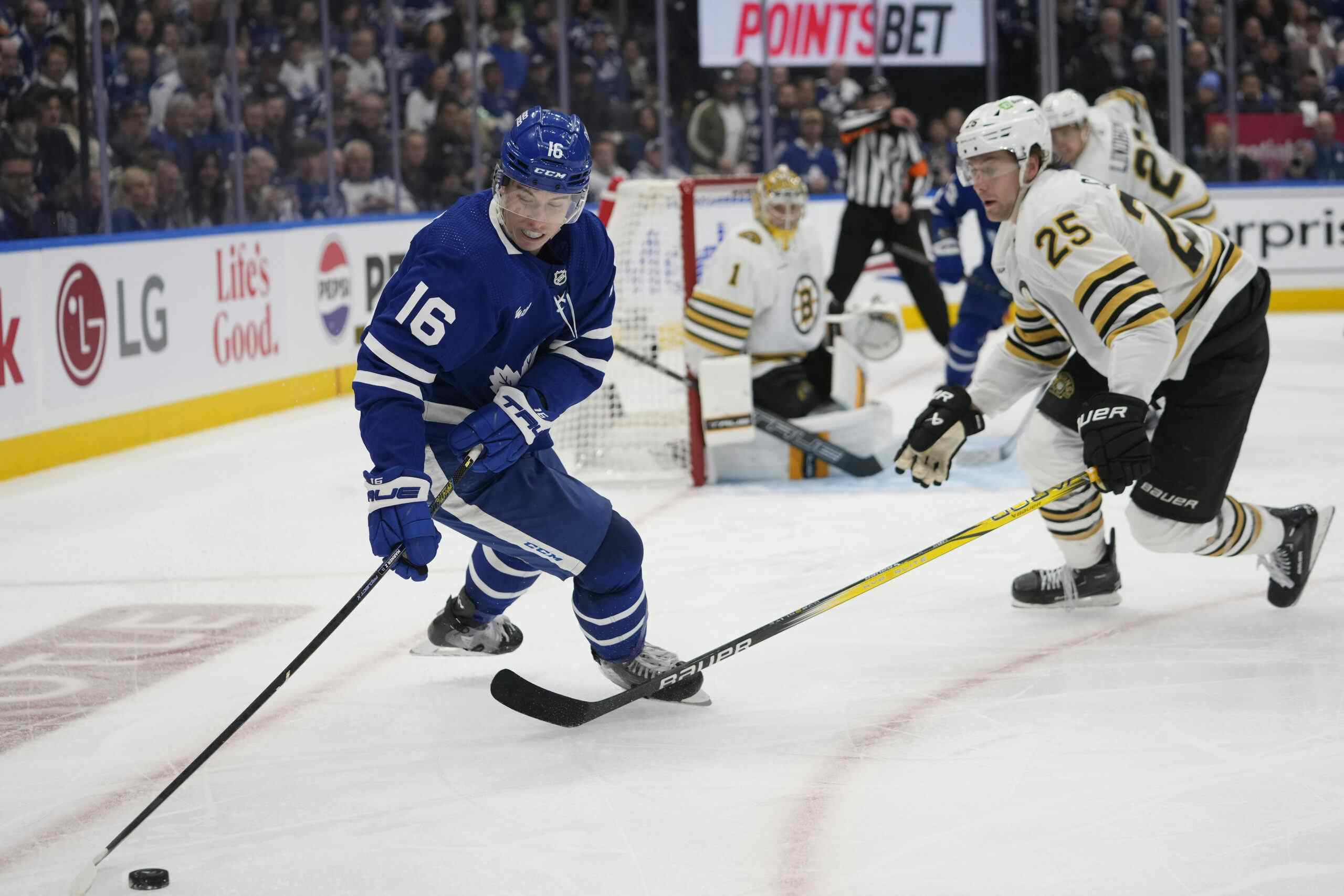Mitch Marner vs. Dylan Strome
By Shawn Reis
8 years agoAll of that Mike Babcock stuff was fun, but the draft is just one month away and it’s time to start turning some of our attention back towards the Leafs’ picks, namely 4th and 24th overall. If ever there was an “age-old debate” for this draft, it would be the debate about who is better between Mitchell Marner and Dylan Strome, two players very much on the Leafs’ radar at 4. You probably already have some sort of idea in your head about who you would take between these two players. But let’s try to look at the debate more closely and objectively to try and figure out once and for all who the better player is.
THE EYE TEST
Mitch Marner plays a very dynamic game rooted in high-end skating, vision, playmaking, and puck-handling. He also has strong offensive instincts and a very accurate wrist shot to boot. Marner is different from your prototypical undersized winger in the sense that he is very good defensively as well. Marner is a zone-entry wizard that is as comfortable passing the puck off to a trailing teammate as he is carrying the puck in himself and he is very dangerous in transition. Marner isn’t a one-trick pony either: he can play the cycle game effectively as well. Overall, he plays a very flashy style that is easy to notice. He’s a real play-driver. Stylistically he plays a lot like Patrick Kane, but I wouldn’t say he’s quite as talented as him.
Dylan Strome is a 6″3′ two-way center that uses his strong vision and pin-point passing ability to create offensive opportunities. That said, Strome also possesses a strong and accurate wrist shot that he is more than happy to use. He has good hands and good offensive instincts. He’s not a very good skater at all, but being 6″3′ should play a big role in negating that. He sometimes lacks consistency at even-strength and looks a lot more like a second-line center at 5v5. Strome is very confident on the powerplay though and shows glimpses of elite upside when he has more room to work with. Overall, Strome plays a well-rounded game but he doesn’t look as dominant as Mitch Marner in either the defensive or offensive zone, and he doesn’t seem to drive offensive play as well either.
Those are my scouting reports on Marner and Strome and I think they speak for themselves. Both have a lot of skill and play well-rounded games, but Marner’s talent is more obvious and in-your-face when you watch the two of them play. Overall, I’d say Marner comes out on top over Strome in the eye test.
THE NUMBERS TEST

No, I didn’t decide to color-code these guys. If a row for a player is green, that means he won that category. Coincidentally, Mitch Marner won all 13 categories used to numerically compare him to Dylan Strome. A real clean sweep.
But there are some more numbers to look at. How about how these players fared when the other top players on their team were out of the lineup? For Marner that means Max Domi, and for Strome that means Connor McDavid.
When Connor McDavid was in the lineup, Dylan Strome averaged 2.08 points per game. When Connor McDavid was out of the lineup, Strome averaged 1.45 points per game. As you might expect, Strome puts up better numbers when McDavid is in the lineup. But a 1.45 points per game without McDavid is pretty darn good, too.
As for Marner, when Max Domi was in the lineup Mitch averaged 1.87 points per game. When Domi was out of the lineup…Marner averaged 2.78 points per game. No, you didn’t read that wrong. Marner’s numbers aren’t only better without Domi, but they are better by a very wide margin (albeit in a pretty small sample size, 11 games).
As for what the projection tools say, the very new and very cool Projection Project says Dylan Strome has an 88% chance of being an NHL player, with 4 of his historical comparables turning out to be elite, 2 of his historical comparables turning out to be 2nd-line players, 1 turning out to be a 3rd-line player, and 1 ending up a bust. Strome’s historical comparables using this tool are Jason Spezza, Taylor Hall, Phil Kessel, John Tavares, Derick Brassard, Pierre-Marc Bouchard, Kyle Wellwood, and Jordan Schroeder (as well as developing players Jonathan Drouin, Jack Eichel, and of course, Mitch Marner). Pretty good company I’d say.
For Marner, the Projection Project says he has a 100% chance of being an NHL player with all 4 of his historical comparables (Jason Spezza, Phil Kessel, John Tavares, and Taylor Hall) turning out as elite. So as good as Strome fared here, Marner still comes out on top.
Using another projection tool, the Prospect Cohort Success % (PCS%) measures a player’s likelihood of playing at least 200 NHL games, taking into account their age, height, point totals, and league.
This tool says Dylan Strome has a 100% chance of playing 200 NHL games and came up with 4 historical comparables (Jeff O’Neill, Todd Harvey, Owen Nolan, and Brendan Shanahan). The NHL points per game of his comparables was 0.70, which equates to 57.4 points over an 82 game NHL season. This seems to align with the idea that Strome is very, very likely to reach his upside, but that his upside is closer to being a second-line center as opposed to a franchise cornerstone.
What this tool says about Marner is that he has an 80% chance of playing at least 200 NHL games, with his historical comparables being Doug Smith, Dan Quinn, Kyle Wellwood, Brad Gratton, and Steve Yzerman. The NHL points per game of his comparables rounded out to 0.88, which equates to 72.16 points over an 82 game NHL season. It should be noted that those numbers are inflated a little bit because of Steve Yzerman, but the fact that Marner compares to Steve Yzerman at all should be considered a significant plus. Overall, these numbers align with the idea that Marner is a very safe pick and that his upside is probably higher than Strome’s.
Both of these players have absolutely fantastic numbers. But, of all the different categories we measured, Strome only came out on top once (% chance of success using PCS%). While almost all of Strome’s numbers are very close to Marner’s, Marner still comes out on top almost every time. Strome is in the conversation, but Marner still takes the cake with relative ease.
THE DEBATE
Objectively speaking, Marner has Strome beat in both the eye test and the numbers test. Like I just said, while Strome is in the same realm as Marner, Marner still edges him out in almost any category you can come up with.
Where Strome certainly does come out on top is the fact that he’s a 6″3′ center. Marner is a 5″11′ winger (Marner can play center, but his playing style is more suited to the wing and his offensive game flourishes more there. For all intensive purposes, let’s call him a winger).
Whether we care to admit it, this does shape our perceptions a good deal. The common sentiment has been, “all things being equal, I’m taking the 6″3′ center over the 5″11′ winger”. And I totally agree with that. The thing is though, I’m not sure Marner and Strome really are equal. Yes, Strome is right in the mix when you compare him to Marner, but at the end of the day Marner comes out on top in nearly every category. They’re close to each other, but in my opinion, they’re not equal.
DISCUSSION
I’m not gonna do any political waffling here, I think Marner has to be considered the better player at this point. Everything suggests that he is. Sure, all things being equal, you take the 6″3′ center over the 5″11′ winger. And while it’s close, I just don’t think they really are equals. I think Marner has Strome beat by enough that I would prefer to take the 5″11′ winger over the 6″3′ center. I think Marner can be a first-line winger. Maybe not as good as Patrick Kane, but if he puts up around 65 or 70 points most seasons and drives offensive play, you can win with that player being the best winger on your team.
For Strome, I really think he ends up more as a strong second-line center. The eye test suggests that he will be. The numbers test is a bit more polarizing, but his numbers without McDavid and the PCS% tool would both suggest he’s not the franchise cornerstone that a lot of people have him made out to be. I’ll take someone I think is a first-line winger over someone I think is going to be a second-line center.
CONCLUSION
I really like Mitch Marner, I really like Dylan Strome, and while he was excluded from this article because of the difficulties of comparing an NCAA defenseman with two OHL forwards, I really like Noah Hanifin too. After McDavid and Eichel, these three players, for my money, have the strongest combination of upside and projectability to the point where I’d put these three in an exclusive category as the “second tier” of this draft class. I wouldn’t be disappointed if the Leafs took any of these players 4th overall. Heck, I even like Ivan Provorov and Mathew Barzal enough that, while I definitely wouldn’t take them 4th overall, I could live with it. In any event, the Leafs are almost assuredly getting a very good player when they (presumably) pick 4th in one month’s time.
But as far as preference goes, I’m taking Mitch Marner 4th overall if the Coyotes haven’t taken him already. My #1 preference is Mitch Marner who I think projects as a first-line winger. My #2 preference is Noah Hanifin, who I think will be a #2 defenseman in the mold of a Jay Bouwmeester. My #3 preference, and I say this as positively as I can because I still think he’s a great prospect, is Dylan Strome, who I think will be a very good second-line center in the NHL.
But, I could be wrong. Such is the nature of the vast unpredictability of the NHL draft.
Other Articles You Might Enjoy:
- The Case for Drafting Mitch Marner
- The Case for Drafting Dylan Strome
- The Case for Drafting Noah Hanifin
- The Case for Drafting Ivan Provorov
- The Case for Drafting Mathew Barzal
Recent articles from Shawn Reis





